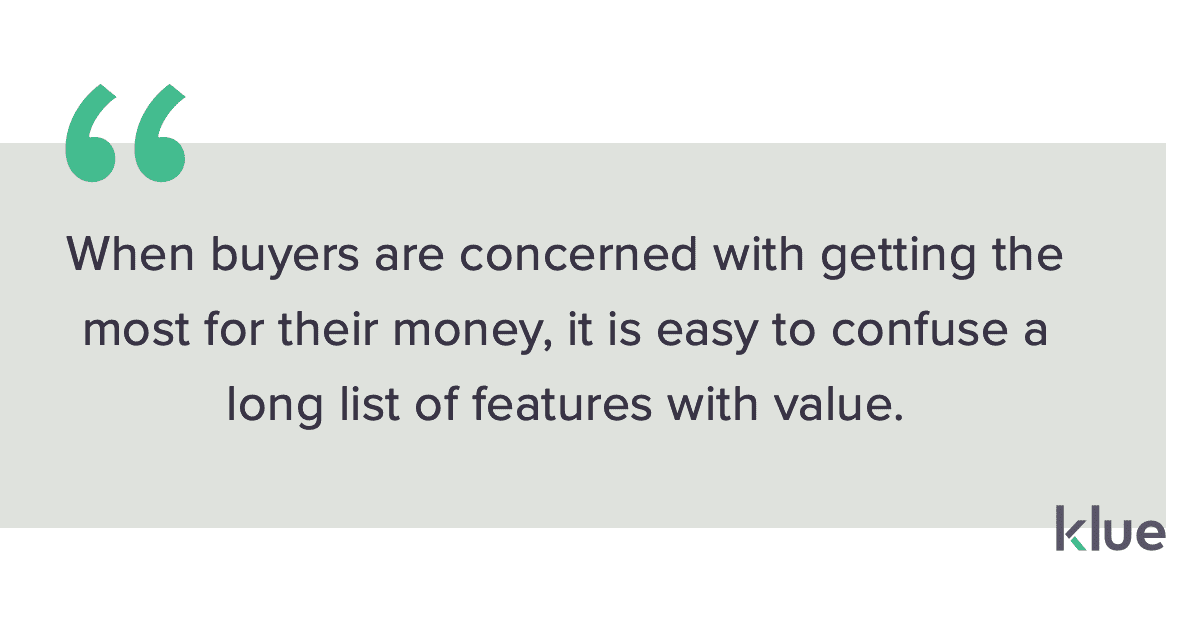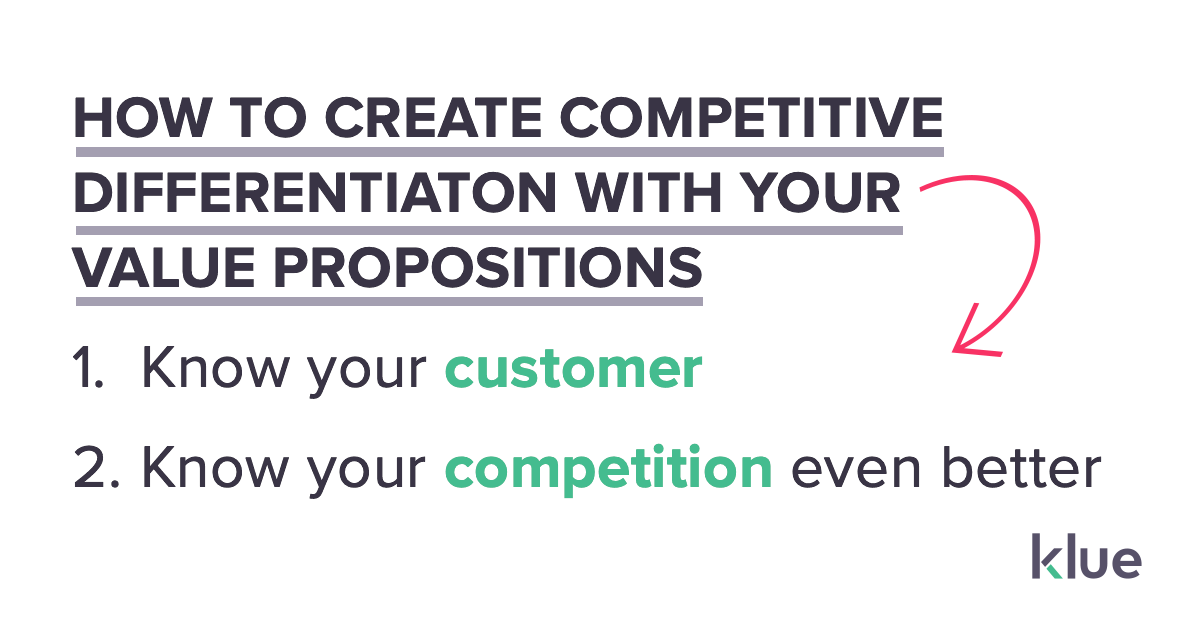Klue Compete
The Competitive Enablement Platform
Learn More
INTRODUCING KLUE INSIGHTS
FIND OUT MORE >

Customers don’t buy features. They buy solved problems.
So why is it so hard to articulate that value to customers in a focused way?
Imagine going to the doctor with an earache. You aren’t necessarily concerned with the brand of medicine the doctor prescribes, or the long list of extra health benefits it promises, just as long as it fixes the pain in your ear.
The same is true for feature-focused value propositions. Without addressing the root of the business problem, features become irrelevant.
Features are familiar. You know your product inside and out and you could sell them in your sleep. Plus they are tangible. It’s much easier to show an impressive list of features than it is to prove ROI to a customer.
The problem is that the buyer doesn’t always know that they aren’t buying features. They can be just as guilty of feature talk as we are. When buyers are concerned with getting the most for their money, it is easy to confuse a long list of features with value.


Good value propositions take those features and translate them into benefits that focus on solving the customer’s pain points. Excellent value propositions actually show the customer why they aren’t buying features. Those are the value propositions that sell against the competition.
When you focus on features you effectively tell the customer what you think should matter to them. A sales oriented perspective is very different from a user’s perspective and influences value propositions in a negative way. It also leaves the door open for your competition to edge you out.
Customers will tune out once you start talking about things that don’t apply to them. When you reframe your value propositions from their perspective it feels less like a sales pitch and more like solving a problem. Even better, it makes them feel like you’re on their side.
This doesn’t mean just listening to what your customers are saying about their business pain points. Learning to think from their perspective is crucial. They are experts in their field, and you are an expert in yours so combining this knowledge will give you a more holistic understanding of the business problem and a fresh perspective for solving it.
It combines deep product knowledge with the marketing ability to translate that into value. It’s the intersection – a familiar concept for a product marketer. This is because features alone don’t differentiate. Neither does messaging. Competitive differentiation hinges on the ability to take the technical aspects of a product, and prove value through messaging. This is where value propositions come into play, however, not all value propositions are created equal. In fact, most suck.
The good news is your product and features are not the issue – customers have a problem and you have a solution. So do your competitors. The focus of value propositions needs to be on how you position yourself as the clear choice.


The better you know your competition, the faster you can spot when they are in a deal. Here are some tips on building a “How to Spot a Competitor” Battlecard.
Restructuring your value propositions means reframing your approach to messaging to focus on the customer’s point of view, analyzing your competition to develop differentiated value propositions, and focusing those propositions to position against them.
In an article for Pragmatic Marketing, Abdul Rastagar from Veeva Systems outlines how to create a structured approach to improving your differentiated value propositions with the Value Proposition Methodology.
Here is a summary of the four tactics involved:
Value propositions need to focus on the end solution. The first step is to know why it’s a problem for customers. You need to understand the broad context of the market and understand where your solution fits in.
Customers are not buying technology for the sake of it. They also aren’t necessarily interested in being more efficient either. What they really want is a solution to a business pain point. Increasing efficiency just happens to be the way to get there so it’s important to recognize that difference.
Know their market position, where they stand in the competitive landscape, how their industry behaves, and even what keeps their CEO awake at night. Understanding the broad context allows you to understand all the factors in why they are seeking a solution and your positioning should reflect this.
The motivation to purchase is unique to each buyer, and they even differ within an organization. Value propositions should address these distinct needs.
Buyer Personas help you understand who you are selling to. Know the difference between who your buyer is, and who the end-user is. Figure out their customer’s needs. Create a well-rounded knowledge of everyone involved in the buying process. Isolate the unique business pains for each persona and combine it with their motivation to buy to frame your value propositions.
Features might make the customer more efficient and we tend to think of this as what will be attractive to our customers. Your customer’s main focus is driving business. This is where value propositions work to translate features into business benefits.
It’s difficult to prove ROI to customers. Messaging is an important way to demonstrate that you truly understand their business pain and that you are confident you can solve it. When it comes down to you vs. a competitor this can be the differentiating factor.
Chances are you and your competition have similar productions and solutions. This is another reason that so many people fall into the feature talk trap. In a head to head competition, if it comes down to listing features then often the outcome will be determined by price. When the focus shifts to pricing, it’s a clear sign that your competition is closing in (learn how to spot the signs here).
In order to avoid this scenario establishing competitive differentiation is mission-critical.
Differentiated value propositioning takes finesse. It takes the aspects of your business that go beyond the product and positions them as equally valuable to customers as product features.
Here are some examples:
The right messaging ties everything together and positions your product in a way that differentiates you from your competitors. It’s the final piece in the puzzle and one that often gets overlooked because it is easy to forget that our customers are not as familiar with our product as we are. Don’t underestimate the power of using language the customer is comfortable with rather than feature talk that is specific to your org.
The power of value propositions is under-appreciated. Describing value seems like common sense, and easily gets pushed further and further down the list of priorities. The good news is that competitive differentiation mobilizes already present aspects of your competitive intelligence program. Reframing propositions to reflect the needs of the customers will help differentiate you from competitors and ultimately win more deals.
Abdul Rastagar from Veeva Systems joined us for session on how to create value propositions that sell. Click here to watch the on-demand webinar.




Competitive Enablement
The topic of Large Language Models (LLMs) has a lot of confusion. Here's what you need to know about how Klue is working with them.


Competitive Enablement
Product Marketing
If your competitive intel game is too strong for automation, too pure for data privacy, and too rebellious for accuracy — then Klue AI is probably not for you.


Let’s do it. Tell us a bit about yourself and we’ll set up a time to wow you.
Let's do it. Tell us a bit about yourself and we'll set up a time to wow you.
XLet's do it. Tell us a bit about yourself and we'll set up a time to wow you.
XSubscribe to get our latest AI functionality and news in your inbox.
XOur Buyer Pulse feature, set to launch in Q2 2024, offers valuable insights into the factors influencing buyer decisions in your pipeline. By signing up for the waitlist, we can better gauge interest and proactively engage with you to streamline the setup and integration process before the feature becomes widely available.
X